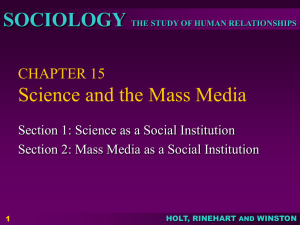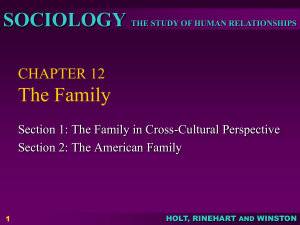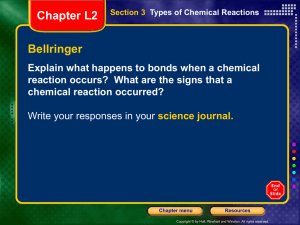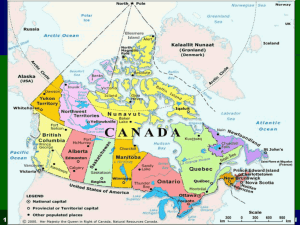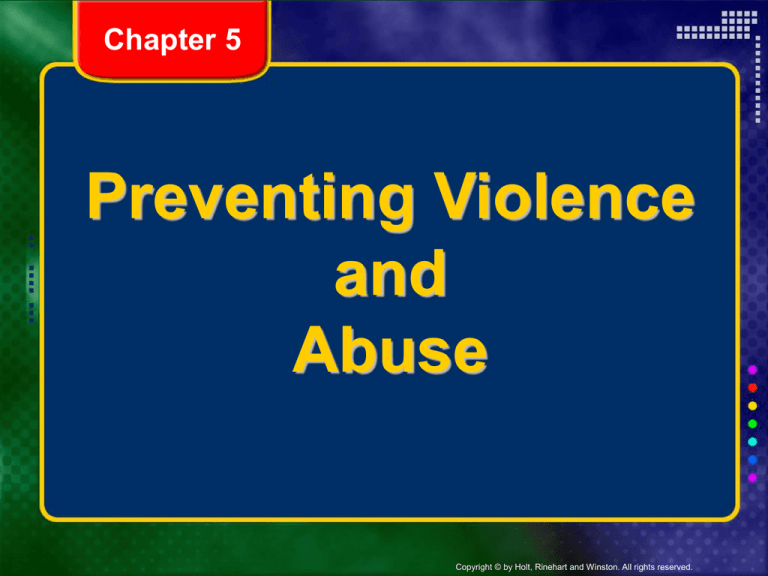
Chapter 5
Preventing Violence
and
Abuse
Copyright © by Holt, Rinehart and Winston. All rights reserved.
How frequently do you engage in the following behaviors?
SCORING:
1 = never
2 = occasionally
3 = most of the time
4 = all of the time
1.
2.
3.
4.
5.
6.
I calm down before telling someone that what he or
she said or did upset me.
I respect others even if they are different from me.
I don’t pick on or tease others.
I don’t carry weapons.
I don’t solve arguments with fights.
I am assertive and communicate directly and
respectfully, not aggressively.
Copyright © by Holt, Rinehart and Winston. All rights reserved.
What’s Your Score???
TOTAL
>19 pts
You are doing an excellent job of
avoiding conflict and violence.
10-18 pts You are doing very well overall but
have areas in which you could
improve your interactions with
other people.
<9 pts
You should be making some major
changes in the ways in which you
interact with other people.
Copyright © by Holt, Rinehart and Winston. All rights reserved.
Chapter 5
Preventing Violence and Abuse
Section 1
Conflict Resolution
And
Violence Prevention
Copyright © by Holt, Rinehart and Winston. All rights reserved.
Chapter 5
Section 1 Conflict Resolution
and Violence Prevention
Violence Around Us
• Violence: any physical force that is used to:
• harm people
• damage property
• We’re surrounded by violence on TV, in movies, in
the newspaper, in video games, in our schools, and
in our homes.
• Seeing and experiencing violence can make you
insensitive to others who are in trouble.
• It can also make you more violent toward others.
Copyright © by Holt, Rinehart and Winston. All rights reserved.
Chapter 5
Section 1 Conflict Resolution
and Violence Prevention
Factors That Lead to Conflicts:
1. Feeling Threatened by Others
2. Unmanaged Anger Fatigue, poor living conditions
and irritability can make one more prone to act out
with anger.
3. Lack of Respect for Others
• HATE CRIMES: Violent acts against people
just because they are of a different race,
religion, or culture.
• TOLERANCE: the ability to overlook
differences and see people for who they are.
Copyright © by Holt, Rinehart and Winston. All rights reserved.
Chapter 5
Section 1 Conflict Resolution
and Violence Prevention
Factors That Lead to Conflicts:
4. Bullying: Scaring or controlling another person
using threats or physical force.
If you are being bullied or see someone else being
bullied:
• Be tolerant of others.
• Don’t be embarrassed to ask for help.
• Be assertive, not aggressive.
• Try to avoid the bullies.
• Respect yourself.
Copyright © by Holt, Rinehart and Winston. All rights reserved.
Chapter 5
Section 1 Conflict Resolution
and Violence Prevention
Factors That Lead to Conflicts:
5. Gangs
•
People may join gangs to feel safe or powerful, to
get respect, or to feel like they belong.
•
Many gangs are violent and destructive to the
community.
•
There are many constructive alternatives to joining
a gang.
Copyright © by Holt, Rinehart and Winston. All rights reserved.
Chapter 5
Section 1 Conflict Resolution
and Violence Prevention
Avoiding Dangerous Situations
If you find yourself in a dangerous situation:
• Recognize the signs
• Calm things down
• Leave the situation
Copyright © by Holt, Rinehart and Winston. All rights reserved.
Chapter 5
Copyright © by Holt, Rinehart and Winston. All rights reserved.
Chapter 5
Section 1 Conflict Resolution
and Violence Prevention
Resolving Conflict Without Violence
KEEP EMOTION OUT OF IT!!!
1. Conflict resolution:
• Focus on and solve the REAL problem
• Don’t complicate things with unrelated issues
• Focus on WHAT is right, not WHO is right
2. Negotiate a peaceful solution
3. Mediation:
• a trained outsider helps with a negotiation.
• each person tells his or her side of the conflict,
then they discuss solutions together.
Copyright © by Holt, Rinehart and Winston. All rights reserved.
Chapter 5
Section 1 Conflict Resolution
and Violence Prevention
Resolving Conflict Without Violence
4. Use Good Communication Skills, including:
•
•
•
•
•
•
•
•
Be respectful, yet assertive.
Use the Making GREAT Decisions model.
Don’t raise your voice or call names.
Allow the other person time to speak.
Don’t make assumptions.
Focus on the real issue.
Be open to change.
Use “I” messages, not “you” messages.
Copyright © by Holt, Rinehart and Winston. All rights reserved.
Chapter 5
Section 1 Conflict Resolution
and Violence Prevention
Tips for Arguments:
1. Once they become emotional they are difficult
to resolve (argue with your mind, not your
heart)
2. Step away from an argument and come back to
it later after you’ve cooled off (see step #1)
3. Unresolved disputes / arguments should be
debriefed later (what was the cause? How can
we prevent this in the future?)
Copyright © by Holt, Rinehart and Winston. All rights reserved.
Chapter 5
Preventing Violence and Abuse
Section 2
Recognizing and Preventing Abuse
Copyright © by Holt, Rinehart and Winston. All rights reserved.
Chapter 5
Section 2 Recognizing and
Preventing Abuse
Bellringer
1. Think about a time that you witnessed verbal
abuse, either in real life or in the media.
2. Think about how the abuser was acting and how
the victim reacted.
3. Think about how did you feel as you witnessed the
abusive behavior?
Copyright © by Holt, Rinehart and Winston. All rights reserved.
Chapter 5
Section 2 Recognizing and
Preventing Abuse
What Is Abuse?
Abuse: physical or emotional harm to someone
•
The most common forms of abuse come from
people one should be able to trust.
•
Abusers are often people who were once abused
themselves
•
Learning to recognize inconsiderate and
disrespectful behavior will help you avoid abusive
people.
Copyright © by Holt, Rinehart and Winston. All rights reserved.
Chapter 5
Section 2 Recognizing and
Preventing Abuse
Types of Abuse
1. Child Abuse As many as 3 million cases of child
abuse are reported every year in the U.S.
•
•
•
•
physical
emotional
sexual
neglect
2. Neglect: when a caretaker fails to provide basic
needs.
Copyright © by Holt, Rinehart and Winston. All rights reserved.
Chapter 5
Section 2 Recognizing and
Preventing Abuse
Types of Abuse
3. Domestic violence: the use of force to control
and maintain power over a spouse or partner.
‘Dating Bill of Rights’ video (Love is Respect.org)
Abusive relationships often go through three
stages:
1. Tension-building phase
2. Violent episode phase
3. Honeymoon phase
Copyright © by Holt, Rinehart and Winston. All rights reserved.
Copyright © by Holt, Rinehart and Winston. All rights reserved.
Chapter 5
Section 2 Recognizing and
Preventing Abuse
Types of Abuse
4. Elder Abuse
• in nursing homes or in their own homes
• can be physical, emotional, or neglect
5. Hazing: harassing newcomers to a group in an
abusive and humiliating way
• may occur in gangs, sports teams, fraternities,
or sororities
Copyright © by Holt, Rinehart and Winston. All rights reserved.
Chapter 5
Section 2 Recognizing and
Preventing Abuse
Tips to Avoid Abuse
•
Create a supportive network of friends and family.
•
Avoid disrespectful people.
•
Be assertive when dealing with potential abusers.
•
Show disapproval if a person does not treat you in
an acceptable way.
Copyright © by Holt, Rinehart and Winston. All rights reserved.
Chapter 5
Section 2 Recognizing and
Preventing Abuse
Tips For Getting Help After Abuse
•
Go somewhere safe.
•
Tell someone.
•
Consider counseling.
Copyright © by Holt, Rinehart and Winston. All rights reserved.
Chapter 5
Preventing Violence and Abuse
Section 3
Sexual Abuse and Violence
Copyright © by Holt, Rinehart and Winston. All rights reserved.
Chapter 5
Section 3 Sexual Abuse and Violence
Sexual Abuse
Sexual abuse: ANY sexual act without consent
Incest: sexual activity between family members
who are not husband and wife
•
When a child is sexually abused by someone
he or she knows and trusts, the child may not
recognize he or she is being abused.
•
The child may also be too ashamed to tell
someone about the abuse.
Copyright © by Holt, Rinehart and Winston. All rights reserved.
Chapter 5
Section 3 Sexual Abuse and Violence
Sexual Harassment
Sexual harassment: any unwanted remark,
behavior, or touch that has sexual content.
• most dangerous when the harasser holds a position
of power.
• If you are being sexually harassed:
1. Tell the harasser to stop
2. Report the harassment
Copyright © by Holt, Rinehart and Winston. All rights reserved.
Chapter 5
Copyright © by Holt, Rinehart and Winston. All rights reserved.
Chapter 5
Section 3 Sexual Abuse and Violence
Sexual Assault and Rape
• Sexual assault: any sexual activity in which
force or the threat of force is used.
• Date rape: sexual intercourse that is forced on
the victim by someone the victim knows.
• Most people who rape do so to gain power and
control, not because they want sex.
• Alcohol and drugs can make you more vulnerable to
sexual assault and rape.
Copyright © by Holt, Rinehart and Winston. All rights reserved.
Chapter 5
Section 3 Sexual Abuse and Violence
Sexual Assault and Rape
• Victims of rape and sexual assault may suffer the
following effects:
• Physical injuries
• Emotional trauma
• Pregnancy or sexually transmitted diseases
• Guilt and shame
• Trouble sleeping and eating
• Post-traumatic stress disorder
Copyright © by Holt, Rinehart and Winston. All rights reserved.
Chapter 5
Section 3 Sexual Abuse and Violence
Protecting Yourself from Sexual Abuse and Violence
• At Home
•Keep doors and windows locked.
•Don’t open the door to strangers.
•Know your neighbors and how to contact others
for help.
• On the Street
•Don’t go out alone, especially at night.
•Walk purposefully.
•Call for help if you feel threatened.
• By People You Know Use the skills you have
learned for recognizing and preventing abuse.
Copyright © by Holt, Rinehart and Winston. All rights reserved.
Chapter 5
Copyright © by Holt, Rinehart and Winston. All rights reserved.
Chapter 5
Section 3 Sexual Abuse and Violence
Help After a Sexual Assault
• If you have been raped or assaulted:
• Make sure you are away from further harm.
• Call for help.
• Don’t change anything about yourself or your
environment. DO NOT TAKE A SHOWER
(EVIDENCE).
• Ask someone to take you to the hospital.
• Seek therapy or counseling.
Copyright © by Holt, Rinehart and Winston. All rights reserved.
End of Chapter 5
Copyright © by Holt, Rinehart and Winston. All rights reserved.

